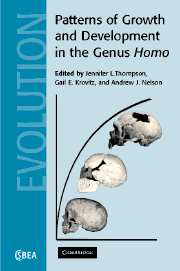Book contents
- Frontmatter
- Contents
- List of contributors
- Acknowledgments
- 1 Introduction
- Part I Setting the stage: What do we know about human growth and development?
- Part II The first steps: From australopithecines to Middle Pleistocene Homo
- 8 Reconstructing australopithecine growth and development: What do we think we know?
- 9 Growth and life history in Homo erectus
- 10 Patterns of dental development in Lower and Middle Pleistocene hominins from Atapuerca (Spain)
- 11 Hominid growth and development from australopithecines to Middle Pleistocene Homo
- Part III The last steps: The approach to modern humans
- Index
- References
9 - Growth and life history in Homo erectus
Published online by Cambridge University Press: 12 August 2009
- Frontmatter
- Contents
- List of contributors
- Acknowledgments
- 1 Introduction
- Part I Setting the stage: What do we know about human growth and development?
- Part II The first steps: From australopithecines to Middle Pleistocene Homo
- 8 Reconstructing australopithecine growth and development: What do we think we know?
- 9 Growth and life history in Homo erectus
- 10 Patterns of dental development in Lower and Middle Pleistocene hominins from Atapuerca (Spain)
- 11 Hominid growth and development from australopithecines to Middle Pleistocene Homo
- Part III The last steps: The approach to modern humans
- Index
- References
Summary
Introduction
Evolution modifies the developmental pattern and thus understanding the evolution of development is critical to identifying how and when the presumed descendant morphological patterns, such as our own, originated. Likewise, understanding how and when these patterns changed ultimately assists in answering why they changed; that is, what evolutionary problems and solutions they reflect. Here we address two aspects of ontogeny in Homo erectus in order to define developmental shifts that have characterized later human evolution. First, we undertake a preliminary heterochronic comparative analysis of cranial ontogeny in H. erectus and H. sapiens. This investigation focuses on alterations in the relations between size, shape, and age at maturation between ancestral and descendant species. Heterochronic transformations can thus be taken to refer, rather narrowly, to shifts in allometric or relative growth trajectories between an ancestor and a descendant species. Using this approach requires both juvenile and adult fossils, although it does not require knowledge of the specific developmental age of each juvenile fossil (Shea, 2000). Second we explore differences in how these taxa grew to reach adult size, with special emphasis on whether or not a growth spurt characterized H. erectus. This component of the research investigates the possibility that growth in H. erectus, like that in H. sapiens, was subdivided into relatively discrete time periods, including a period prior to an adolescent growth spurt and a period after the initiation of the growth spurt.
- Type
- Chapter
- Information
- Patterns of Growth and Development in the Genus Homo , pp. 219 - 245Publisher: Cambridge University PressPrint publication year: 2003
References
- 11
- Cited by

